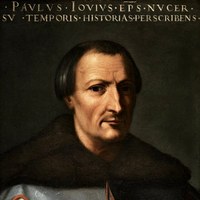Paolo Giovio

Paolo Giovio owes his fame to the Historiae sui temporis and to the extraordinary collection of portraits, kept in the villa-museum in Como. After studying medicine between Padua and Pavia, he moved to Rome. An insatiable intellectual curiosity led him to compose treatises such as De romanis piscibus (1524) and De optima victus ratione (1527), and, later, the famous Dialogue of enterprises (1555). In Rome he experienced the devastation of the sack of 1527 and immediately fled to Ischia near Vittoria Colonna where he composed the Dialogus de viris et foeminis aetate nostra florentibus. To urge a new crusade project, he wrote the Commentario de le cose de 'Turchi (1531), in which he demonstrated that he was able to assess the impact of the Near East on European politics. After the death of Clement VII and Cardinal Ippolito de 'Medici, Giovio found a new point of reference in Cardinal Alessandro Farnese with whom he discussed on several occasions a project for the libertas Italiae based on an alliance between the pope and the emperor . Moreover, the explicit defense of imperial politics and a substantial lack of interest in the processes of reform of the Church, soon led him to clash with Paul III, who denied him the benefits of the bishopric of Como and in fact forced him to retire, in 1549. , in his house on the Lario. The following year he moved to Florence to the court of Duke Cosimo, where he finally put his hand to the Historiae. The first book was prepared for the types of Lorenzo Torrentino while the printing of the second volume was completed in the late summer of 1552, a few months before his death which occurred on the night between 11 and 12 December.

 +34 954 610 124
+34 954 610 124






